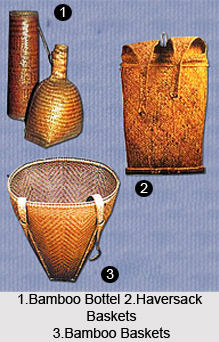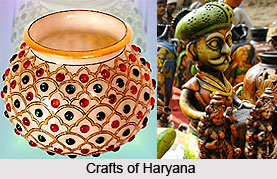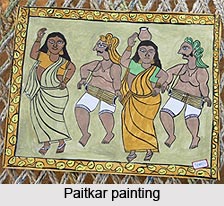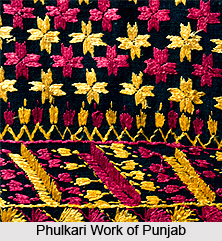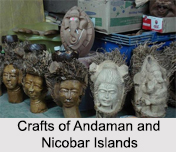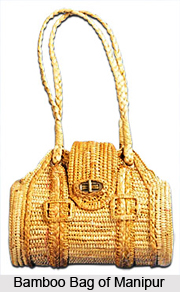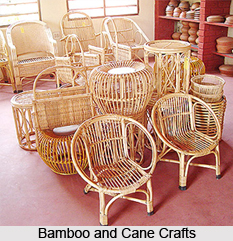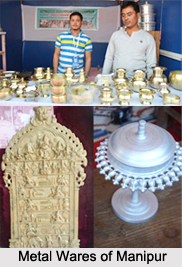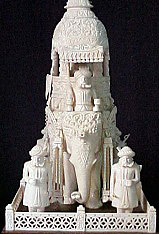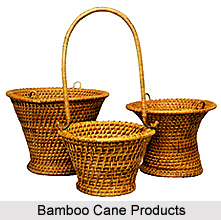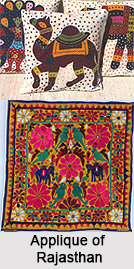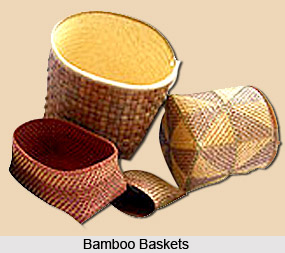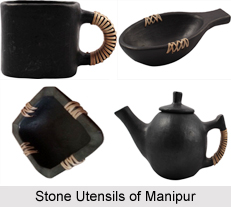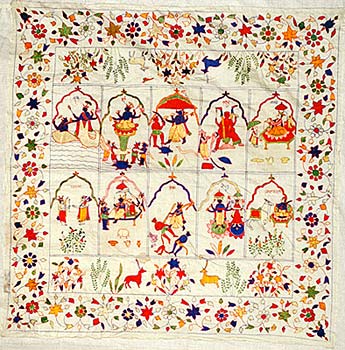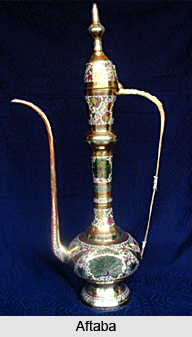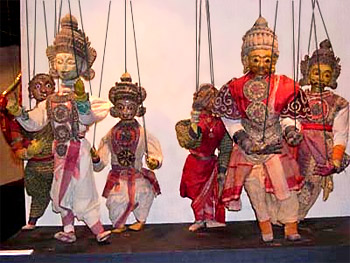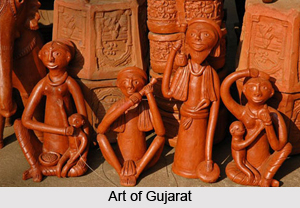 Clay Crafts of Western India is the mouth piece of the lustrous craft of India, as and when it comes to the flowing aura of the cultural refinement of the Western India.
Clay Crafts of Western India is the mouth piece of the lustrous craft of India, as and when it comes to the flowing aura of the cultural refinement of the Western India.
Clay crafts of Maharashtra are concentrated on the edge of Vara where the pottery community lives. The clay crafts in Maharashtra are mainly carried out by women and most of the male members of the community have engaged themselves in factory works. The potters of Maharashtra consider themselves superior to the brick makers which form an important class of the region. In Maharashtra there are many factors affecting the potter`s position in this hierarchy, ranging from geographic (potters living near sacred places gaining respectable position over potters living in socially inferior areas) to technological (the superiority of potters using the wheel to those working with simple tools). The potters of Maharashtra belong to Sudra community.
The month of February is the production season for the potters of Maharashtra. They make a range of different sized water and grain storage pots for the approaching Shivaratri festival to celebrate the wedding of Lord Shiva and Parvati. In Maharashtra pots are ordered by traders who come and collect them in a truck and resell in various markets. Traditions demand that the renewal of clay food containers to mark each important event in a person`s life should also coincide with religious festivals. Although the porosity of earthenware vessels is ideal for storing and cooking food, they become contaminated through continual use and need to be replaced, the broken shreds returning to the earth from which they were created in a perfect cycle.
The making season in Maharashtra is October-May; during the monsoon the potters will supplement their lack of income by working for local farmers in the paddy fields. The custom of the region is that before clay preparation begins a puja is done where incense and flowers are offered in the family shrine to ask for a blessing from god. Four parts of clay are mixed with two parts of sieved horse dung and one of sieved ash. In the preparation of clay includes first the sieved ash is spread on the ground, then the clay and sieved dung put into a hollow container set into the ground and mixed with water until the consistency of thin cream. Each area has developed its own techniques for clay preparation depending on the quality of the clay and local materials available.
In Maharashtra red iron clay is bought from the market and made into a slip (gheru) which is applied with a cloth a few hours before firing. Beans from the arita tree are threaded into several strands resembling a necklace, then dipped into kerosene and rubbed over the surface of the slipped pots to give a burnish. The round-bottomed pots are supported in a hollow in the ground and covered with sacking during the beating stage. The rim is finished in the same way with a wet cloth, but carried out before the beating stages happen.
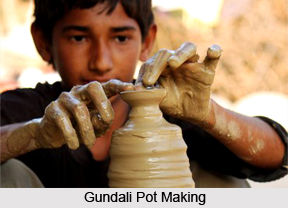 Kutch has a rich tradition particularly in the decorative arts of pottery, embroidery, printed and woven textiles, wall painting, jewellery and leatherwork. In spite of the fact that Kutch has climatic extremities this region of Gujarat is known to have a rich culture in the field of Clay Crafts. Clay Crafts of Kutch also have a different dimension besides the normal pot making. The pastoral communities of Kutch place high value on the art of decoration and the patterns executed on their pottery reflect these rich traditions. Lodai and Khavda are important regions in the district of Kutch which are known for its clay crafts.
Kutch has a rich tradition particularly in the decorative arts of pottery, embroidery, printed and woven textiles, wall painting, jewellery and leatherwork. In spite of the fact that Kutch has climatic extremities this region of Gujarat is known to have a rich culture in the field of Clay Crafts. Clay Crafts of Kutch also have a different dimension besides the normal pot making. The pastoral communities of Kutch place high value on the art of decoration and the patterns executed on their pottery reflect these rich traditions. Lodai and Khavda are important regions in the district of Kutch which are known for its clay crafts.
Clay Crafts in Lodai
The potters of Lodai are Muslim and highly regarded for the quality of their work, especially in the rich and varied slip decoration executed by women. A wide range of vessels are produced to fulfil the requirements of a dozen different communities and tribes residing in the area, including Rabari (tribal nomadic sheep and camel herders), Jats (Muslim shepherds and farmers), Ahir (farmers) as well as blue collar workers and labourers working in more modern fields of transportation and construction. Particular vessels have associations with individual communities. Just as personal adornment in the form of clothes and jewellery can express group identity, so the form and decoration of a clay vessel can take on this function - and is strongly preserved here. The potter families in Lodai are gradually decreasing in number.
In Lodai the potters are not in the process of pot making from the months July to September. During this time the potters rent land and cultivate them. The various types of vessels that are prepared in Lodai are dry storage vessels for grain and flour, vessels for liquids include those for carrying water, storing water, making and storing buttermilk. Very large vessels for water storage known as kothi are also made by the potters of Lodai.
Water is carried to large distances in vessels like ghaddo, bhaddak, bhambhudi which are produced with small mouths to reduce spillage. Each design has a groove in the neck around which a rope is tied to secure the vessels during transport, whether on the person`s back or on a camel or bullock cart. Buttermilk vessels also come in various sizes with different widths at the mouth; larger ones are used for making buttermilk which is stored in the smaller ones with narrower mouths to facilitate pouring. Vessels for milk have relatively high necks with narrow openings, reflecting their function of carrying milk into the fields.
Many types of cooking vessels are made in the region of Lodai. Those which are exposed to heat have enlarged thick rims (so the vessel can be handled when hot) wide mouths and gentle contours. Foodstuffs such as rice and milk are boiled in a kunnu, which has a sufficiently wide mouth to allow stirring. Other ingredients which need to be stirred frequently while cooking, such as vegetables and meat, are placed in wide mouthed vessels with almost flat bases - taplo.
The tavdi, used to make rotlo (a type of bread) comes in two sizes. The kachchi tavdi, used for making the large rotlo eaten by pastoral communities, is bigger, thicker and has a handle so it can be manipulated more easily when hot. The smaller tavdi, used in urban contexts, has only a thicker outer rim for easier handling. Many of the cooking vessels - sakio and tavdo - have a sharp angle between the rim and neck, providing a grip for easy handling. Vessels which are used for food preparation - kathrot - are open and shallow with a flat base, and those used as eating utensils - tabak, nani patar, sanak - are also open and shallow with a rim base to add stability whilst eating. Amongst the Muslim community it is traditional for all members to eat from a communal plate, and there are a variety of sizes to accommodate requirements. Ritual pots for marriage, death and birth are modifications of these pots in daily use but with different decorations.
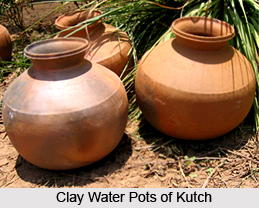 Khavda in Kutch is another region which excels in clay crafts. Clay crafts in Khavda have an altogether different dimension. The beauty of clay crafts in Khavda is witnessed in the form of bhunga which is a round hut made from mud and wood with a thatched conical roof. The thick walls are thatched in nature with excellent insulating properties well suited to the intense summer heat and the circular structure has a higher survival rate during earthquake. Each bhunga has a small separately built rectangular kitchen, and the bathing area consists of a stone slab set into the ground outside, screened by bushes. Some of the walls are painted with rich geometric patterns in earth colours of pink, yellow ochre and black, the lines and marks bearing a close resemblance to embroidery stitches.
Khavda in Kutch is another region which excels in clay crafts. Clay crafts in Khavda have an altogether different dimension. The beauty of clay crafts in Khavda is witnessed in the form of bhunga which is a round hut made from mud and wood with a thatched conical roof. The thick walls are thatched in nature with excellent insulating properties well suited to the intense summer heat and the circular structure has a higher survival rate during earthquake. Each bhunga has a small separately built rectangular kitchen, and the bathing area consists of a stone slab set into the ground outside, screened by bushes. Some of the walls are painted with rich geometric patterns in earth colours of pink, yellow ochre and black, the lines and marks bearing a close resemblance to embroidery stitches.
Although the contents of the bhunga are limited to life`s bare essentials, the intricate relief decoration and inlaid mirrors which catch and reflect the light convey a rich and lavish environment. The various designs which form an intricate part of Bhunga are kungri - border, butti - small flowers, vel creeper, handhia - camels, panihari -woman with water pot, mor or peacock.
